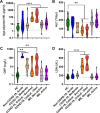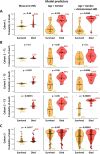This is a preprint.
Prognostic Value of Serum/Plasma Neurofilament Light Chain for COVID-19 Associated Mortality
- PMID: 35075461
- PMCID: PMC8786234
- DOI: 10.1101/2022.01.13.22269244
Prognostic Value of Serum/Plasma Neurofilament Light Chain for COVID-19 Associated Mortality
Update in
-
Prognostic value of serum/plasma neurofilament light chain for COVID-19-associated mortality.Ann Clin Transl Neurol. 2022 May;9(5):622-632. doi: 10.1002/acn3.51542. Epub 2022 Mar 21. Ann Clin Transl Neurol. 2022. PMID: 35313387 Free PMC article.
Abstract
Given the continued spread of severe acute respiratory syndrome coronavirus 2 (SARS-CoV-2), early predictors of coronavirus disease 19 (COVID-19) mortality might improve patients’ outcomes. Increased levels of circulating neurofilament light chain (NfL), a biomarker of neuro-axonal injury, have been observed in patients with severe COVID-19. We investigated whether NfL provides non-redundant clinical value to previously identified predictors of COVID-19 mortality. We measured serum or plasma NfL concentrations in a blinded fashion in 3 cohorts totaling 338 COVID-19 patients. In cohort 1, we found significantly elevated NfL levels only in critically ill COVID-19 patients compared to healthy controls. Longitudinal cohort 2 data showed that NfL is elevated late in the course of the disease, following two other prognostic markers of COVID-19: decrease in absolute lymphocyte count (ALC) and increase in lactate dehydrogenase (LDH). Significant correlations between LDH and ALC abnormalities and subsequent rise of NfL implicate multi-organ failure as a likely cause of neuronal injury at the later stages of COVID-19. Addition of NfL to age and gender in cohort 1 significantly improved the accuracy of mortality prediction and these improvements were validated in cohorts 2 and 3. In conclusion, although substantial increase in serum/plasma NfL reproducibly enhances COVID-19 mortality prediction, NfL has clinically meaningful prognostic value only close to death, which may be too late to alter medical management. When combined with other prognostic biomarkers, rising longitudinal NfL measurements triggered by LDH and ALC abnormalities would identify patients at risk of COVID-19 associated mortality who might still benefit from escalated care.
Figures




References
-
- Alirezaei Z., Pourhanifeh M. H., Borran S., Nejati M., Mirzaei H., and Hamblin M. R. (2020). Neurofilament Light Chain as a Biomarker, and Correlation with Magnetic Resonance Imaging in Diagnosis of CNS-Related Disorders. Mol. Neurobiol. 57, 469–491. doi:10.1007/s12035-019-01698-3. - DOI - PMC - PubMed
-
- COVID Live Update - Worldometer Available at: https://www.worldometers.info/coronavirus/ [Accessed December 5, 2021].
Publication types
LinkOut - more resources
Full Text Sources
Miscellaneous
